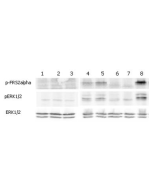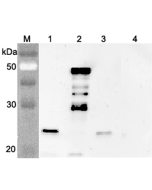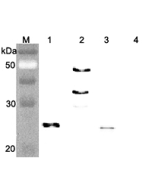Cookie Policy: This site uses cookies to improve your experience. You can find out more about our use of cookies in our Privacy Policy. By continuing to browse this site you agree to our use of cookies.
Chimerigen
FGF-21 (mouse) (rec.)

| Product Details | |
|---|---|
| Synonyms | Fibroblast Growth Factor 21 |
| Product Type | Protein |
| Properties | |
| Source/Host | HEK 293 cells |
| Sequence | The extracellular domain of mouse FGF-21 (aa 30-210) is fused at the N-terminus to a FLAG®-tag. |
| Crossreactivity | Mouse |
| MW | ~23kDa (SDS-PAGE) |
| Purity | ≥90% (SDS-PAGE) |
| Endotoxin Content | <0.06EU/μg purified protein (LAL test; Lonza). |
| Reconstitution |
10µg vial: Reconstitute with 100 µl sterile water to a concentration of 0.1mg/ml. 50µg vial: Reconstitute with 50 µl sterile water to a concentration of 1mg/ml. Add 1X PBS to the desired protein concentration. |
| Formulation | Lyophilized from 0.2μm-filtered solution in 1X PBS. |
| Other Product Data |
NCBI link NP_064397.1: FGF-21 (mouse) FLAG is a registered trademark of Sigma-Aldrich Co. |
| Shipping and Handling | |
| Shipping | BLUE ICE |
| Short Term Storage | +4°C |
| Long Term Storage | -20°C |
| Handling Advice |
Avoid freeze/thaw cycles. Centrifuge lyophilized vial before opening and reconstitution. |
| Use/Stability |
Stable for at least 1 year after receipt when stored at -20°C. Working aliquots are stable for up to 3 months when stored at -20°C. |
| Documents | |
| Product Specification Sheet | |
| Datasheet |
 Download PDF Download PDF |
Fibroblast growth factor 21 (FGF-21) is a member of the fibroblast growth factor family and has been identified as an important regulator of energy metabolism connecting nutrition, growth, reproduction and longevity. FGF-21 lacks the heparin-binding domain of most FGF proteins, allowing its secretion. FGF-21 is abundantly expressed in adipose tissues, liver and pancreas. In adipose tissue, FGF-21 promotes glucose uptake and oxidation and in liver it replenishes on fasting the tissues with fuel on low nutritional supply. It also induces lipolysis and ketogenesis. FGF-21 acts through FGF receptors (FGFR) associated with the auxiliary protein β-Klotho. Recently, FGF-21 has been reported to interact directly with the brain circadian clock to coordinate activity and reproduction as part of the adaptation to fasting. Due to its multiple functions of normalizing glucose, lipid and energy homeostasis, FGF-21 represents an attractive novel therapy for type 2 diabetes mellitus and obesity.









